People and spades
And the woman's crying will end
When, puffing out fiercely cheeks,
The campaign will be played by the headquarters trumpeter.
Peaks will easily pierce the sky.
Stirrups will creak slightly.
And someone will move with a wild gesture
Yours, Russia, tribes.
Alexey Eisner
Military affairs at the turn of the eras. The pico, a long spear with a narrow tip, was the first in Europe to use the Scots in their shiltron formation to defend against the attacks of knightly cavalry. Then the pikes were used by the pikemen's infantry, but the riders were armed with it quite late, somewhere in the XNUMXth century. But she held out in the ranks of the cavalry until the very beginning of World War II! In Russia, whoever was not armed with lances, although traditionally the lance is considered a Cossack weapons... In 1801, the lancers received the peaks, as expected. Well, in the 1840s, the cavalry pike became the weapon of the first ranks not only in the Uhlan cavalry, but also in the dragoon cavalry, it was received by the hussars, and even the cuirassiers. However, today the story will not be about them, that is, our Russian pike cavalrymen, but about horsemen with pikes in Europe and America after the collapse of Napoleon's empire and up to 1918.
Last time, when it came to the participation of the American dragoon cavalry in the war with Mexico, some commentators noted the high efficiency of the Mexican cavalrymen, armed with pikes and also a lasso. So who were these horsemen, how many were there, and how did they act in battles?
To begin with, Mexico went to war with the United States, assuming that its larger army would certainly win, but things didn't go as planned. The American cavalry honed their combat prowess in conflicts with the Indians and were probably the most well-equipped and high-class cavalry force in the world at the time. Mexico, on the other hand, inherited traditional Spanish military doctrine, including many French features adopted by its officers after Napoleon's occupation of Spain in 1808-1813. Although the Spaniards themselves were expelled from Mexico in 1829, the army retained units called cuirassiers, hussars, lancers and dragoons. But it didn't work out to properly equip and arm them ...
Therefore, the cavalry was created, which most corresponded to local conditions, the so-called californios. In accordance with the rules of 1837, each regiment was ordered to have four squadrons of two companies in each. The composition of each company consisted of a captain, a lieutenant, two ensigns, a first sergeant, three second sergeants, nine corporals, two trumpeters, 52 mounted soldiers and eight dismounted soldiers. And in each such regiment, the first company of each squadron was to be armed with pikes - a weapon popular in the Mexican cavalry. These spears were made of beech or walnut, had a length of 3 m and three- or four-sided points 20 cm long with grooves. The lance barrel had a thickness of 3 cm. From firearms they had flintlock and primer pistols and old carbines. For example, a large number of Tower muzzle-loading muskets came from Great Britain, where their production and use was discontinued in 1838, but then resumed in Mexico.
In addition to the regular regiments, the Mexican army had 17 irregular and 12 independent presidial lancer companies. These companies, numbering from 50 to 60 people, were called so because they were located in the "presidio" (border forts). In 1846, on the San Diego to San Pasquale road, a 75-man Californian presidio engaged several companies of the 1st American Dragoon Regiment under the command of Colonel Kearney. The dragoons could not use their firearms, because the gunpowder was wet, so they had to fight with melee weapons and lost three officers and 15 soldiers, and the same number were wounded. Among the Mexicans, one lancer was captured and ten were wounded.
The Mexican command envisaged the creation of many such irregular companies, armed with pikes in case of war. The tasks of these units included reconnaissance, patrolling and striking enemy communications. In 1843, a division was formed, which received the name "Jalisco Spearmen". He had two squadrons, and the horsemen were dressed in the Polish manner. All cavalry historians note that the Mexicans were born horsemen and rode fine horses, with a lot of Arab and Spanish blood. Horses of this breed are still found in Mexico and are highly prized.
As for Europe, the restoration of royal power in France and the exile of Napoleon to the island of St. Helena did not bring her much peace. One of the decisions of the Congress of Vienna (1815) was the creation of the Kingdom of Sardinia (Piedmont), which also included the former Republic of Genoa. The House of Savoy soon lost its independence and became a vassal of Austria, but the desire for independence put Piedmont at the forefront of the struggle for the unification of Italy. From 1848 to 1866, with short breaks, the Italians fought three times against Austria, and its inhabitants did not shed their blood in vain: the small states of northern Italy were able to free themselves from the power of the Austrians and unite.
The French Revolution of 1830 raised great hopes among the Italian patriots of the Risorgimento. Accordingly, in Piedmont, the quality of the training of soldiers, especially in the cavalry, was immediately improved, and its reorganization was carried out, reflected in the charter adopted in 1833. In 1835, six cavalry regiments were transformed into two brigades: the 1st, consisting of the cavalry of Nice, Savoy and Novara, the second largest city of Piedmont, and the 2nd, consisting of the Piedmont Reale, Genoa Guards and the Aosta cavalry. The following year, the same six regiments were grouped into three brigades, and already in 1841 each of them had six squadrons, one of which was armed with pikes. In peacetime, the regiment numbered 825 people and 633 horses, in wartime - 1128 people and 959 horses.
It should be noted here that the beginning of the 1811th century in French art was marked by the rise of classicism, and it drew inspiration from Ancient Greece, the ideas of a free civil society, which also served as a model for the French Revolution. In the field of military technology, classicism found a vivid expression in the cavalry helmet, which was a copy of the ancient Greek samples. In 1815, such a ridge helmet was issued to the French line lancers and carabinieri; in 1833, the British Life Guards and Belgian Carabinieri; shortly thereafter, it was carried by almost all the heavy cavalry of Europe. The Piedmont charter of 1840 also provided for the use of such a helmet, and it was made in XNUMX by the court painter Palagio Palaggi and named "Minerva's helmet."
In 1848, upon learning of the revolution in Vienna, the inhabitants of Milan also revolted and drove the Austrian garrison out of the city, and Piedmont immediately declared war on Austria. The cavalry of Nice played a significant role in the battles of this war. A certain sergeant Fiora lost his horse and was surrounded by four Austrian lancers; he killed one with a lance, wounded the other, and chased the remaining two away, rushing after them. A similar feat was accomplished by Sergeant Prato, also surrounded by four Austrians, this time by hussars; he killed one and drove out the other three. Nevertheless, the campaign itself, which lasted a year, ended ... with the defeat of the Italians. Austrian rule over Lombardy and Venice continued. And Piedmont had to pay Austria an indemnity of 65 million francs.
Nearby, beyond the Bosphorus, in the Turkish army, as well as in the state itself after the Napoleonic wars, changes also began. So, under Sultan Mahmud II (1803-1839), a whole series of reforms was carried out in the Turkish army in order to make it similar in organization, training, weapons and tactics to the army of Western Europe. As a result, it was divided into regular forces (nizam), reserve (redif) and last call (mutahfiz).
The regular army served six years, and recruits were chosen by throwing the dice. Each young man was required to attend the roll of the dice several times a year, and if he was not selected within five years, he was automatically transferred to the reserve.
Since 1843, each regular cavalry regiment had six squadrons, and, in addition to rifles and sabers, the second, third, fourth and fifth of them were armed with pikes. The squadron consisted of 120 people; the whole regiment with headquarters numbered 736 people (and 934 people, if we also take into account the auxiliary personnel). In 1879, the number of squadrons was reduced to five per regiment, two regiments made up a brigade, three brigades made up a cavalry division. The cavalrymen were armed with American Winchester and Remington rapid-fire magazine rifles and inflicted heavy losses on Russian soldiers in the 1877-1878 war.
In 1885, a volunteer cavalry corps was created, called "Hamidiye Siivari Alayari" ("Sultan Hamid's detachment"). Its regiments included members of the same tribe and had serial numbers starting with one. They were called up for training every three years, and in other cases - only if necessary. Their people equipped themselves, and only weapons came from the imperial reserves. Since the warriors of the Hamidiye cavalry came from different tribes, the soldiers of each of them wore their own national costume, the Ottoman authorities chose the three most common national costumes and ordered that men wear one of them when they come to service. In addition, they also had to wear special tags with the name and number of their regiment on their clothes so that they could be distinguished from the general population.
In 1869, the Turkish cavalry consisted of 186 squadrons of the regular army and 50 volunteer regiments (20 Circassian, 30 Kurdish and Arab), and in case of war, auxiliary and irregular cavalry units (bashibuzuks) were to be called up. Auxiliary armies from Egypt, Tunisia and Tripoli were supposed to fight under the Turkish flag. In 1876, the auxiliary contingent from Egypt was ten cavalry regiments: four hussars, four dragoons, and two lancers.
Each of them had five squadrons of 122 people each.
Bashibuzuk can be translated as “sick in the head,” and the popular explanation for this term is based on the fact that in Ottoman Turkey, different races, religions, religious orders, classes and professions differed from each other mainly in headdresses. During the reforms in the army, uniforms of the European type were introduced, and the army and civil servants had to wear fez. All the rest were allowed to wear whatever they wanted, including on their heads, and the bashi-bazouks used this. About 10000 Bashi-bazouk cavalry from Asia Minor, Kurdistan and Syria took part in the Crimean War, where the British General Beatson attempted to transform them into a disciplined fighting force. But all his efforts were unsuccessful.
It is interesting that India, conquered by the British, also created its own armed forces, and their creation went in parallel with the colonial expansion. The first Indian troops were organized by the British East India Company soon after it established its first outposts in the country in the middle of the 1857th century. They consisted of European mercenaries and local residents, whose task was to protect trading posts. After the end of the Seven Years War in Europe, three armies were formed in India: Madras, Bombay and Bengal. Low wages, innovations that offend the religious feelings and ancient traditions of the indigenous people, and especially the social and economic changes brought about by British rule, have been the reasons for the frequent uprisings of Indian servicemen. The largest of these, known as the Indian Rebellion (1868-560) or, in Soviet historiography, the Sepoy Rebellion, led to the abolition of the East India Company and the introduction of dual rule. The provinces under direct administration made up British India, and the XNUMX Indian states were ruled by local princes who were vassals of the British crown and who often had to be disciplined by force of arms. How this happened was described very well by Rudyard Kipling in his novel "Kim". It is understood that during the mutiny all the regular and some irregular Indian regiments were disarmed.
In 1861, the Anglo-Indian Army was reorganized, after which a Fourth Army was formed in the Punjab. The Bengal army was purged and replenished with soldiers loyal to the British crown. Nineteen cavalry regiments, known simply as the Bengal Cavalry, were re-formed and numbered 1 through 19. Since these units were armed with pikes, their name was soon changed so that they were now all lancers.
At the beginning of the 1861th century, a soldier entering the army had to come with a horse, weapons and equipment. But after the reorganization of XNUMX, the government began to pay the regiments money according to the number of personnel for the purchase of uniforms and equipment. The irregulars paid more than the other regular regiments, but there weapons were the only thing the government gave out to the soldiers for free.
Interestingly, the Bengali cavalry regiments consisted of people of different races and religions, therefore, in order to avoid conflicts within the regiment, the squadrons were made up of representatives of the same caste, race or religion. They all wore the same uniform, but they were allowed to wear turbans that matched their religious preferences. So, in 1897, the 2nd Bengali regiment of the ulan had one squadron of Sikhs, Jats, Rajputs and Hindu Mohammedans each. And they all had turbans of different styles on their heads. At the same time, the Sikhs did not tolerate the Jats, considering them stupid buffaloes, and the Hindu Mohammedans - Rajputs, whom their religion made it a duty to drink wine and eat meat.
Bengal Lancers took part in many British colonial campaigns, including Egypt in 1882 and Sudan in 1884-1885, as well as the First World War against the Germans on the Western Front and the Turks in the Middle East. The Bengal lancers were armed with a lance with a bamboo shaft and a square tip, a standard British light cavalry saber and Lee Metford carbines. An interesting feature was their shoulder straps, which were also used by the Uhlan regiments of the metropolis and were made of ... chain mail!
To be continued ...
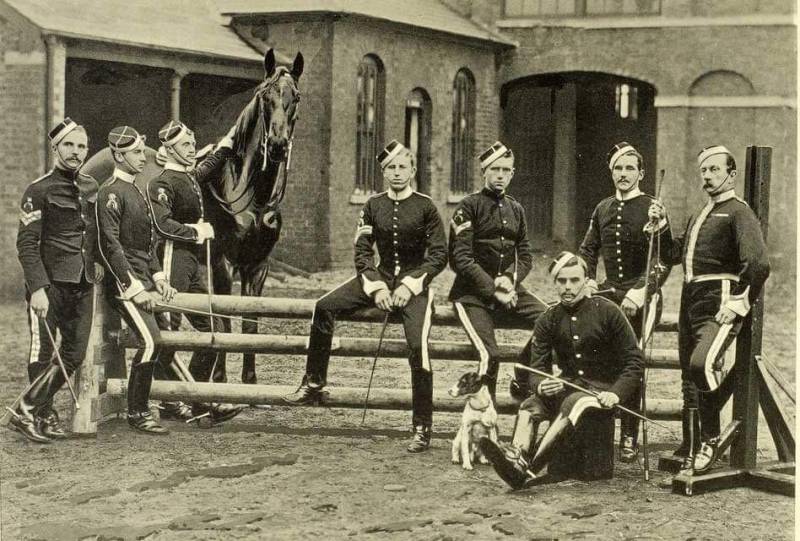
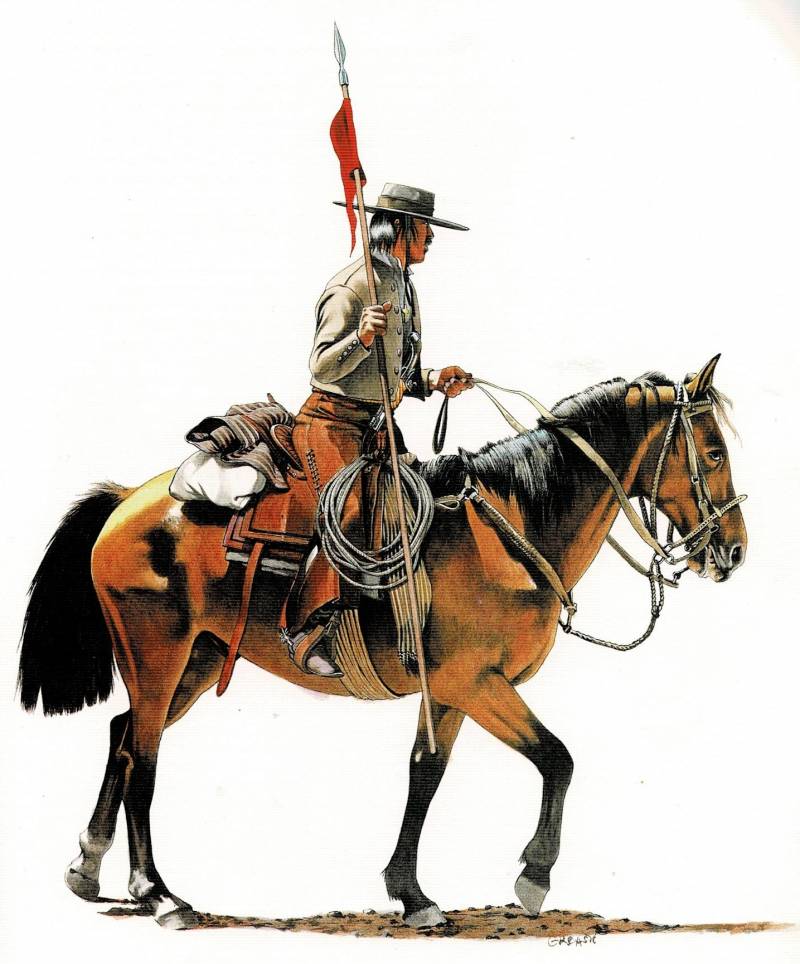
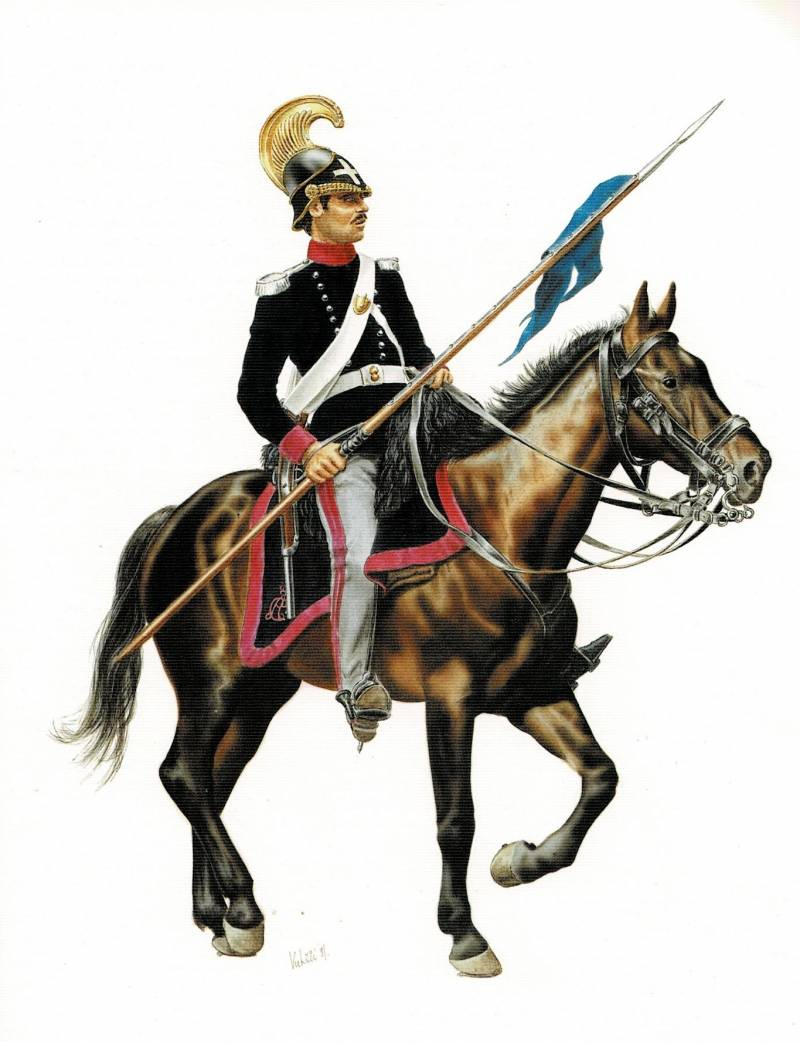
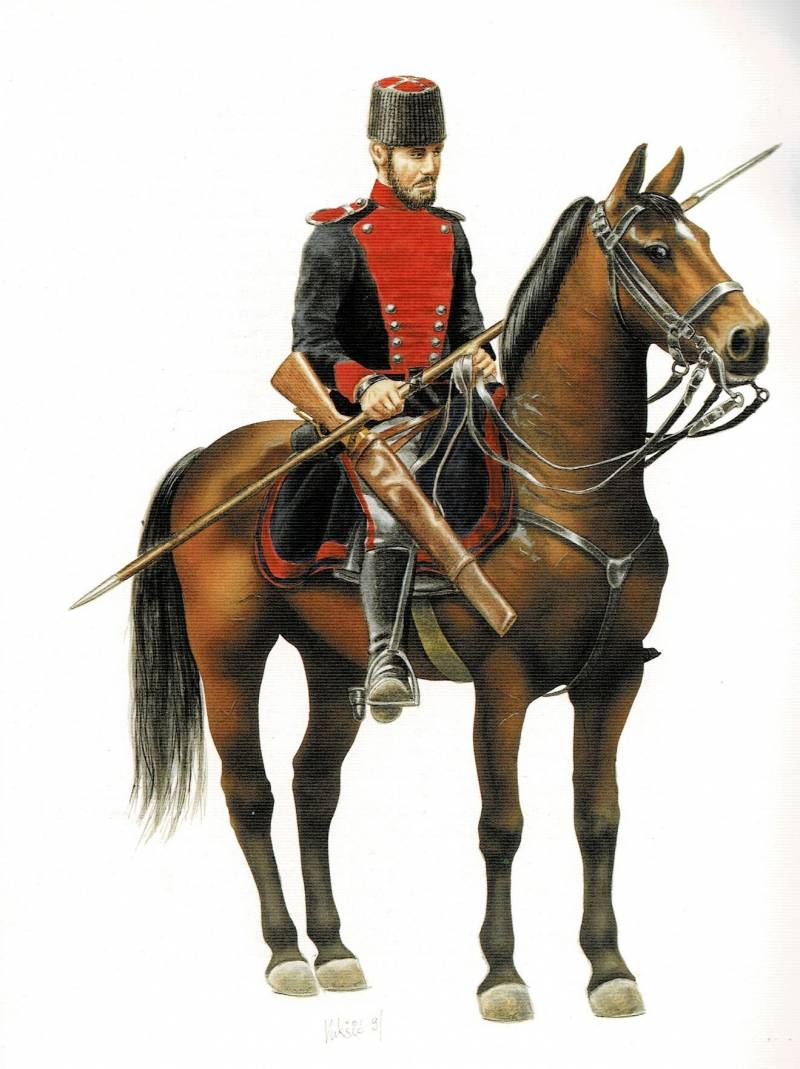
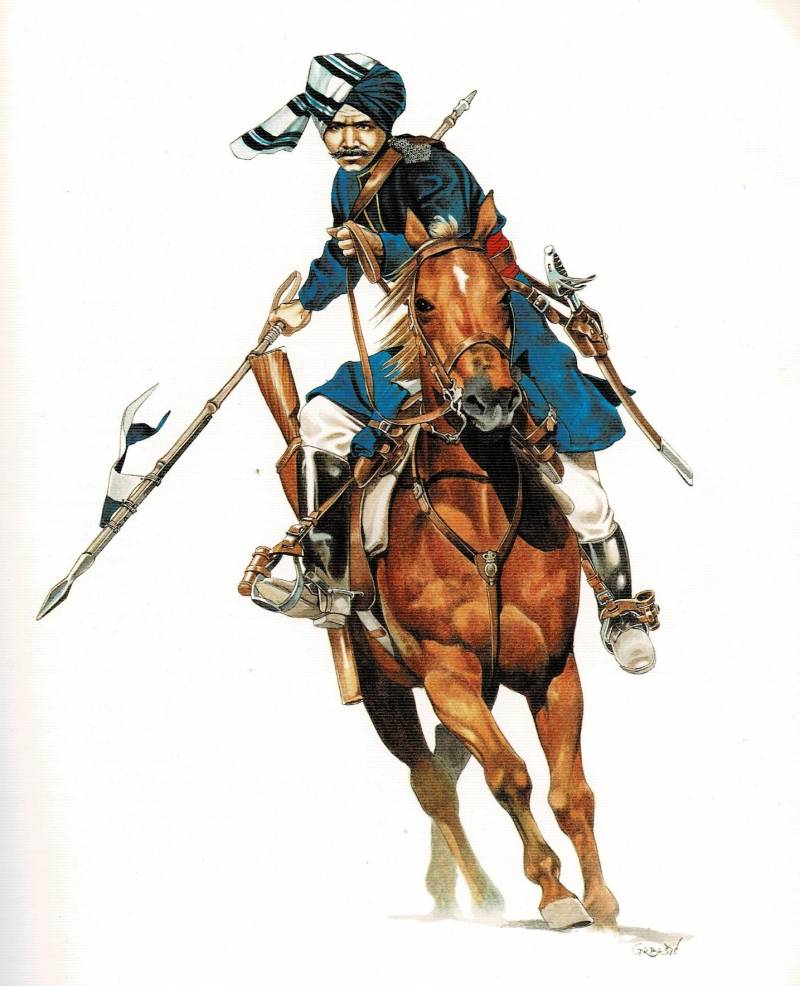
Information